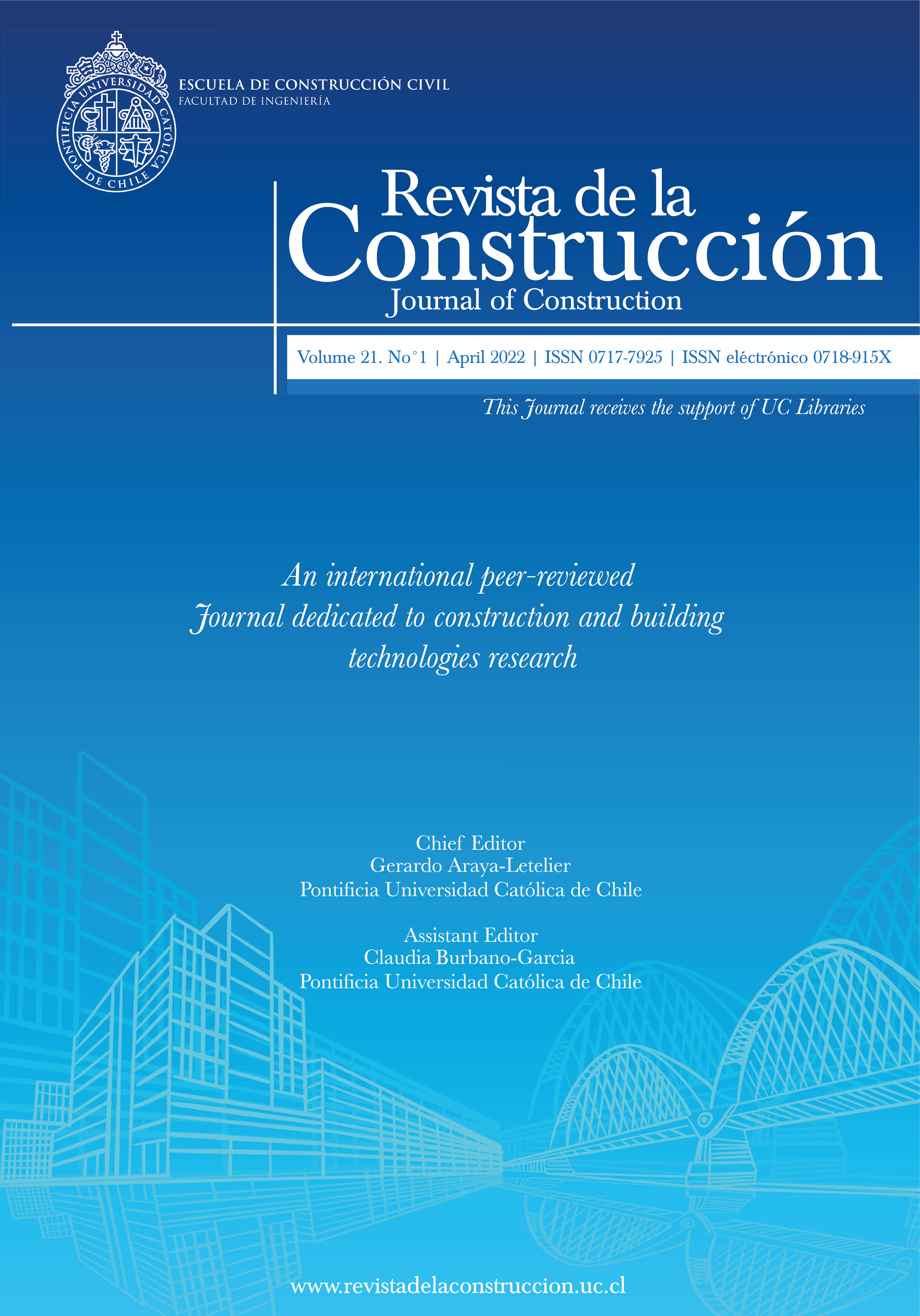Compressive resistance level effect on impact performance of fi-ber reinforced concrete
DOI:
https://doi.org/10.7764/RDLC.21.1.135Keywords:
fibre reinforced concrete, compressive resistance, steel fibres, drop-weight impact test, residual strengthAbstract
impact resistance represents a key property of fiber reinforced concrete (FRC). To study this property, a test method was recently proposed; which consists in repeated drops of a projectile on simply supported prisms, and allows to evaluate FRC behavior both at cracking and after cracking. With the aim of verifying the sensitiveness of this method, this paper analyzes the influence of the compressive strength of the FRC matrix on each parameter of the impact test. Three FRC incorporating 30 kg/m3 of hooked-end steel fibers were prepared, varying the water/cement ratio (0.59, 0.50 and 0.43). It was found that although only small effects on the cracking energy were observed as the concrete compressive strength increases, the post-cracking energy increased in a greater proportion. However, the cracking growth rate, an impact parameter strongly sensitive to the type and content of fibers, remained practically constant for different compressive strength levels.
References
ACI Committee 544. (1999). Measurement of Properties of Fiber Reinforced Concrete 544.2R-89. ACI (Vol. 544.2R). Retrieved from http://civilwares.free.fr/ACI/MCP04/5442r_89.pdf
ACI Committee 544. (2017). Report on Measuring Mechanical Properties of Hardened Fiber Reinforced Concrete. ACI 544.9R-17.
American Society for Testing and Materials. ASTM C 39M (2003), Standard Test Method for Compressive Strength of Cylindrical Concrete Specimens (2003).
American Society for Testing and Materials. (2006). ASTM C 469 – 02 Standard Test Method for Static Modulus of Elasticity and Poisson ’ s Ratio of Concrete. Annual Book of ASTM Standards, i, 2–6.
Banthia, N. P. (1987). Impact Resistance of Concrete. The University of British Columbia.
Instituto Argentino de Racionalización de Materiales. NORMA IRAM 50000 - Cemento para uso general (2000).
International Federation for Structural Concrete (fib). (2012). Model Code Volume 1.
Mindess, S., & Zhang, L. (2009). Impact resistance of fibre-reinforced concrete. Proceedings of the Institution of Civil Engineers: Structures and Buildings, 162(1), 69–76. https://doi.org/10.1680/stbu.2009.162.1.69
Sateshkumar, S. K., Awoyera, P. O., Kandasamy, T., Nagaraj, S., Murugesan, P., & Ponnusamy, B. (2018). Impact resistance of high strength chopped basalt fibre-reinforced concrete. Revista de La Construccion, 17(2), 240–249. https://doi.org/10.7764/RDLC.17.2.240
Technical Committee CEN/TC 229. EN 14651:2005 Test method for metallic fibered concrete - Measuring the flexural tensile strength (limit of proportionality (LOP), residual) Méthode (2005).
Ulzurrun, G., & Zanuy, C. (2017). Flexural response of SFRC under impact loading. Construction and Building Materials, 134, 397–411. https://doi.org/10.1016/j.conbuildmat.2016.12.138
Vivas, J.C., Isla, F., Torrijos, M. C., Giaccio, G., Luccioni, B., & Zerbino, R. (2021). Drop-Weight Impact Test for Fibre Reinforced Concrete: Analysis of Test Configuration. In RILEM-fib XI International Symposium on Fibre Reinforced Concrete.
Vivas, J.C., Zerbino, R., Torrijos, M. C., & Giaccio, G. (2021). A Test Procedure for Evaluating the Impact Behaviour of Fibre Reinforced Concrete. Materials and Structures.
Vivas, Juan C., Zerbino, R., Torrijos, M. C., & Giaccio, G. (2020a). Effect of the fibre type on concrete impact resistance. Construction and Building Materials, 264, 120200.
Vivas, Juan C., Zerbino, R., Torrijos, M. C., & Giaccio, G. M. (2020b). Impact response of different classes of fibre reinforced concretes. In P. Serna, A. LLano Torre, J. Martí Vargas, & J. Navarro-Gregori (Eds.), RILEM-fib X International Symposium on Fibre Reinforced Concrete (pp. 189–198).
Yoo, D. Y., Yoon, Y. S., & Banthia, N. (2015). Flexural response of steel-fiber-reinforced concrete beams: Effects of strength, fiber content, and strain-rate. Cement and Concrete Composites, 64, 84–92. https://doi.org/10.1016/j.cemconcomp.2015.10.001
Yu, R., Van Beers, L., Spiesz, P., & Brouwers, H. J. H. (2016). Impact resistance of a sustainable Ultra-High Performance Fibre Reinforced Concrete (UHPFRC) under pendulum impact loadings. Construction and Building Materials, 107, 203–215. https://doi.org/10.1016/j.conbuildmat.2015.12.157
Downloads
Published
How to Cite
Issue
Section
License
Copyright (c) 2022 Juan Carlos Vivas, Raúl Zerbino

This work is licensed under a Creative Commons Attribution-NonCommercial-NoDerivatives 4.0 International License.





